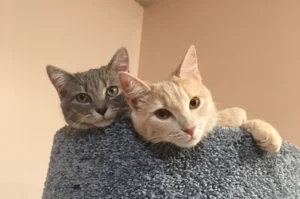Cats are known for their independent and sometimes mysterious nature. One common behavior that cat owners may observe is when a cat attacks an older cat. This behavior can be puzzling and concerning for pet owners, but understanding the reasons behind it can help in addressing the issue effectively.
When a cat attacks an older cat, it could be due to a variety of reasons such as territorial behavior, redirected aggression, fear or stress, medical issues, or lack of socialization. By identifying the root cause of the aggression, pet owners can take steps to prevent future attacks and ensure the well-being of their feline companions.
Territorial Behavior
Cats are known for being fiercely territorial creatures. This means they can become aggressive towards other cats, especially older ones, when they feel like their territory is being invaded. It’s important to understand that cats are very particular about their space and can feel threatened by the presence of another cat, leading to aggressive behavior.
One way to help prevent this aggression is by providing each cat with their own designated spaces within the home. This can include separate feeding areas, litter boxes, and sleeping spots. By giving each cat their own territory, you can help reduce the chances of conflict between them.
Redirected Aggression
Sometimes, cats may exhibit redirected aggression towards older cats when they are unable to direct their frustration towards the actual source of their stress. This can happen if a younger cat is feeling anxious or agitated due to a change in the environment or routine. Instead of lashing out at the cause of their stress, they may target an older cat that is nearby.
It’s essential to identify the root cause of the redirected aggression and work towards resolving it. Providing enrichment activities for your cats, such as toys, scratching posts, and interactive playtime, can help alleviate stress and redirect their energy in a positive way.
Additionally , if you notice signs of aggression between your cats, it’s crucial to intervene and separate them if necessary. It’s always best to consult with a veterinarian or a certified animal behaviorist for guidance on how to address aggression in cats effectively.
Remember, understanding why cats attack older cats is essential in addressing and preventing aggressive behavior between your feline companions. By creating a harmonious environment and addressing any underlying stress or territorial issues, you can help your cats coexist peacefully.
Fear or Stress
When it comes to understanding why cats attack older cats, fear or stress can often be a primary factor. Cats, like humans, can become anxious or scared in certain situations, leading them to lash out aggressively. Older cats, with their potential frailty and vulnerability, may be easy targets for younger, more energetic cats looking to assert dominance or relieve their own stress.
If your older cat is continuously being attacked by a younger feline companion, try to identify any triggers that may be causing fear or stress. Changes in the environment, such as introducing a new pet or moving to a new home, can disrupt the harmony among your cats and provoke aggressive behavior. Providing safe spaces, like hiding spots or elevated areas, can give your older cat a peaceful retreat away from potential threats.
Additionally, incorporating interactive play sessions and mental stimulation activities for all your cats can help release pent-up energy and reduce stress levels. Creating a positive and enriching environment can promote peaceful interactions and minimize the likelihood of aggression towards older cats.
Medical Issues
When it comes to cats attacking older felines, underlying medical issues can play a significant role in triggering aggressive behavior. Cats are masters at masking pain or discomfort, and this can manifest in aggression towards other cats, particularly older ones who may already be dealing with age-related ailments themselves.
If you notice a sudden change in your cat’s behavior towards older companions, it’s essential to rule out any medical conditions that could be causing distress. Common issues like dental problems, arthritis, or urinary tract infections can cause heightened irritability and aggression in cats. A visit to the veterinarian for a thorough examination can help pinpoint any health issues that may be contributing to aggressive behavior.
In addition to addressing any medical concerns, ensuring each cat has their own resources, such as food and water bowls, litter boxes, and resting areas, can help reduce competition and potential conflicts among cats in multi-pet households.
Bonus Tip: Introducing vertical spaces, such as cat trees or shelves, can provide older cats with a safe escape route and vantage points to observe their surroundings, promoting a sense of security and reducing the likelihood of attacks from other cats.
For further information on feline aggression and possible solutions, you can check out this resource from the American Association of Feline Practitioners: Understanding Feline Aggression.
Remember, a holistic approach that addresses both emotional and physical needs can help create a harmonious environment for all your cats to coexist peacefully.
Lack of Socialization
When it comes to cats attacking older felines, a lack of socialization plays a significant role. Cats that were not properly socialized during their formative years may struggle to interact peacefully with other cats, especially older ones. Kittens learn essential social skills through play and interaction with their littermates and mother. Without this early socialization, they may not know how to communicate effectively with other cats, leading to misunderstandings that can escalate into aggression.
Cats that missed out on learning important feline body language cues during their early development may misinterpret older cats’ behavior and signals, leading to conflicts and potential attacks. To address this issue, pet owners should prioritize proper socialization for their cats from a young age. This can involve exposing kittens to different people, animals, environments, and gentle handling to help them feel more comfortable and confident in various social situations. By promoting positive interactions early on, pet owners can help prevent aggression towards older cats in the future.
Tips for Managing Aggression
Managing aggression between cats in a household can be challenging but crucial for maintaining a harmonious environment. Here are some practical tips and strategies to help pet owners address and minimize aggressive behavior:
Provide Sufficient Resources : Ensure that all cats in the household have access to their essentials, such as food, water, litter boxes, scratching posts, and resting areas. Competition over resources can trigger aggression, so having enough for everyone can prevent conflicts.
Create Separate Spaces : Cats are territorial animals, so it’s essential to provide each cat with their own space where they can feel safe and secure. This could involve setting up multiple litter boxes and feeding stations in different locations to reduce competition and potential sources of conflict.
Utilize Positive Reinforcement : Rewarding good behavior with treats or praise can help encourage positive interactions between cats. When cats display calm and non-aggressive behavior towards each other, reinforce this behavior to promote harmony and reduce tension.
Consult with a Veterinarian : If aggression persists despite efforts to manage it, seek advice from a veterinarian or animal behaviorist. Underlying medical issues or behavioral problems could be contributing to the aggressive behavior, and professional guidance can help address these issues effectively.
Engage in Play Therapy : Interactive play sessions with each cat can help release pent-up energy and reduce stress, potentially lowering the likelihood of aggressive outbursts. Use interactive toys to engage cats in stimulating play sessions that promote bonding and positive interactions.
By implementing these tips and strategies, pet owners can work towards managing and minimizing aggression between cats in the household, creating a more peaceful and harmonious living environment for everyone involved.
Seeking Professional Help
If despite your best efforts, your cats continue to show aggression towards older felines, it may be time to seek professional help. A veterinarian or animal behaviorist can provide insightful recommendations and strategies to address the root cause of the aggression. Remember, professional guidance can make a huge difference in resolving cat-to-cat conflicts.
By taking the step to consult with an expert, you show your commitment to providing the best care for your feline companions. Professional intervention can help you understand and address the reasons behind why cats attack older cats effectively.
Creating a Harmonious Environment
To foster peace among your feline family, it’s crucial to understand the dynamics at play. By acknowledging the reasons behind cat aggression towards older cats, you can take steps to create a harmonious environment for all your furry friends. Here are a few tips to help you get started:
- Provide plenty of vertical space for your cats to escape or observe from a safe distance.
- Offer multiple resources like food, water, and litter boxes in different locations to prevent competition.
- Monitor their interactions closely and intervene if you notice escalating tensions.
- Encourage positive social interactions through playtime and gentle introductions.
By implementing these strategies, you can help your cats coexist peacefully and enjoy a happy, harmonious household.
Alex, a passionate animal lover, has experience in training and understanding animal behavior. As a proud pet parent to two dogs and three cats, he founded AnimalReport.net to share insights from animal experts and expand his knowledge of the animal kingdom.




